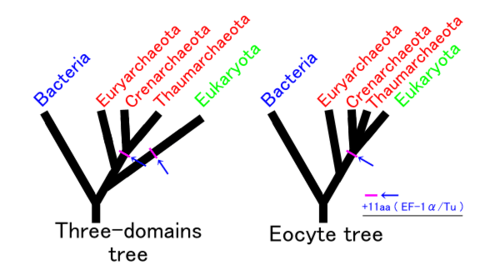Eocyte hypothesis
| Karyota | |
|---|---|
 | |
| Ignicoccus hospitalis (and its symbiote Nanoarchaeum equitans) | |
| Scientific classification | |
| (unranked): | Archaea or Arkarya |
| (unranked): | Karyota Lake et al. 1988[1] |
| Domain & Regnum | |
| |
| Synonyms | |
| |
The Eocyte hypothesis is a biological classification that indicates eukaryotes emerged within the prokaryotic Crenarchaeota (formerly known as eocytes), a phylum within the archaea. This hypothesis was originally proposed by James A. Lake and colleagues in 1984 based on the discovery that the shapes of ribosomes in the Crenarchaeota and eukaryotes are more similar to each other than to either bacteria or the second major kingdom of archaea, the Euryarchaeota.[2][3]
The eocyte hypothesis gained considerable attention after its introduction due to the interest in determining the origin of the eukaryotic cell. This hypothesis has primarily been in contrast with the three-domain system introduced by Carl Woese in 1977. Additional evidence supporting the eocyte hypothesis was published in the 1980s, but despite fairly unequivocal evidence, support waned in favor of the three-domain system.[1][2]
With advancements in genomics, the eocyte hypothesis experienced a revival beginning in the mid-2000s. As more archaeal genomes were sequenced, numerous genes coding for eukaryotic traits have been discovered in various archaean phyla, seemingly providing support for the eocyte hypothesis. In addition to a Crenarchaeal origin of eukaryotes, some studies have suggested that eukaryotes may also have originated in the Thaumarchaeota.[2][4][5][6][7]

References
- 1 2 Lake, James A. (1988). "Origin of the eukaryotic nucleus determined by rate-invariant analysis of rRNA sequences". Nature. 331 (6152): 184–186. doi:10.1038/331184a0. PMID 3340165.
- 1 2 3 Archibald, John M. (23 December 2008). "The eocyte hypothesis and the origin of eukaryotic cells". PNAS. 105 (51): 20049–20050. doi:10.1073/pnas.0811118106. Retrieved 5 October 2012.
- ↑ Lake, James A.; Henderson, Eric; Oakes, Melanie; Clark, Michael W. (June 1984). "Eocytes: A new ribosome structure indicates a kingdom with a close relationship to eukaryotes". PNAS. 81 (12): 3786–3790. doi:10.1073/pnas.81.12.3786. PMC 345305
 . PMID 6587394. Retrieved 5 October 2012.
. PMID 6587394. Retrieved 5 October 2012. - ↑ Kelly, S.; Wickstead, B.; Gull, K. (2011). "Archaeal phylogenomics provides evidence in support of a methanogenic origin of the Archaea and a thaumarchaeal origin for the eukaryotes" (PDF). Proceedings of the Royal Society B. 278: 1009–1018. doi:10.1098/rspb.2010.1427. Retrieved 5 October 2012.
- ↑ Poole, Anthony M.; Neumann, Nadja (2011). "Reconciling an archaeal origin of eukaryotes with engulfment: a biologically plausible update of the Eocyte hypothesis" (PDF). Research in Microbiology. 162: 71–76. doi:10.1016/j.resmic.2010.10.002. Retrieved 5 October 2012.
- ↑ Guy, Lionel; Ettema, Thijs J. G. (December 2011). "The archaeal 'TACK' superphylum and the origin of eukaryotes". Trends in Microbiology. 19 (12): 580–587. doi:10.1016/j.tim.2011.09.002. PMID 22018741. Retrieved 5 October 2012.
- ↑ Cox, Cymon J.; Foster, Peter G.; Hirt, Robert P.; Harris, Simon R.; Embley, T. Martin (23 December 2008). "The archaebacterial origin of eukaryotes". PNAS. 1105: 20356–20361. doi:10.1073/pnas.0810647105. PMC 2629343
 . PMID 19073919. Retrieved 5 October 2012.
. PMID 19073919. Retrieved 5 October 2012.